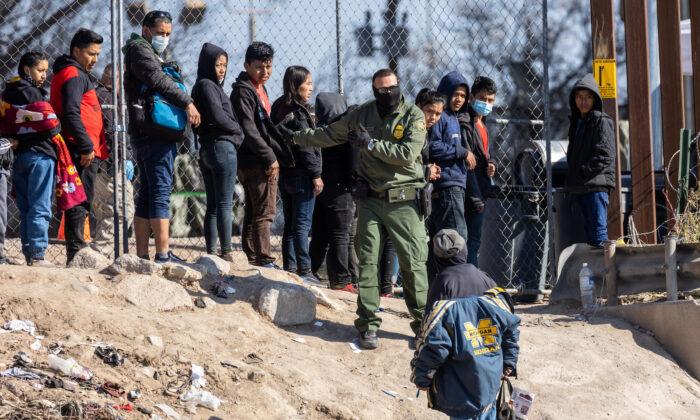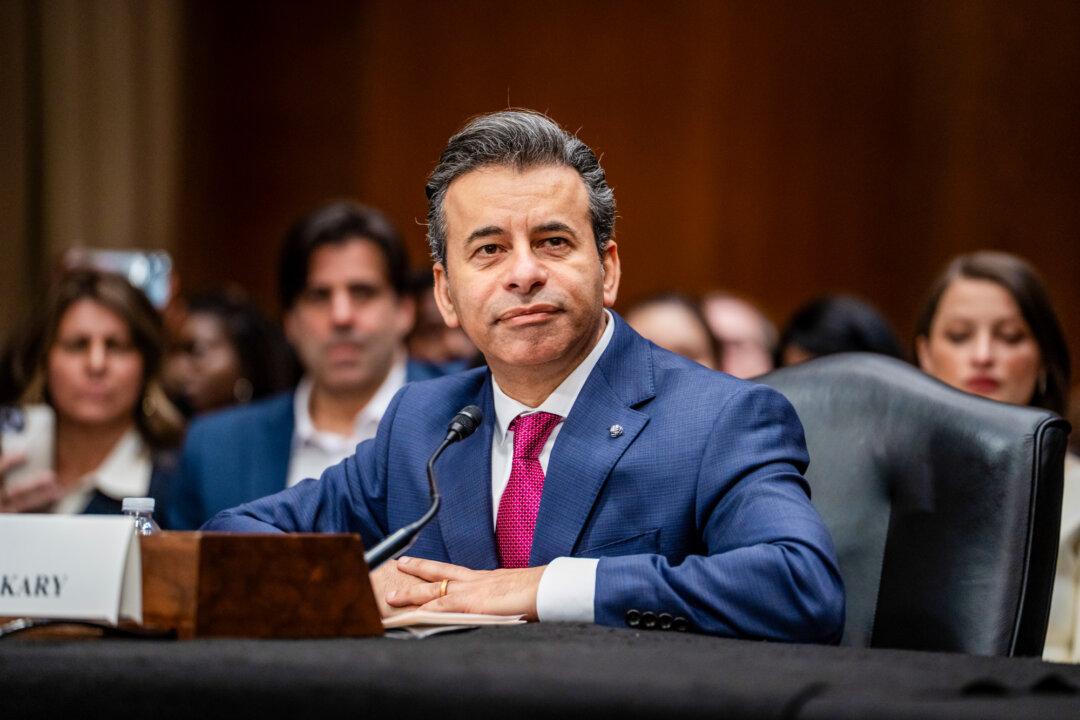While Americans celebrate Christmas, multiple cities across the country brace for what will happen if the Supreme Court decides to end Title 42 as federal border officials report a record number of illegal immigrant crossings at the U.S.–Mexico border.
On Dec. 23, data from U.S. Customs and Border Protection showed that, in November, the agency recorded 233,740 migrant encounters across the southern border, which stretches almost 2,000 miles.
That marks more than a 30 percent increase compared to the same period in November 2021.
About 16 percent of the illegal immigrants apprehended by federal border officials last month had previously attempted to enter the United States, according to Department of Homeland Security information.

As Republicans prepare to take over the House in January, many elected officials in the party have promised that illegal immigration will be a significant focus in 2023.
Title 42 is at the forefront.
Created as part of the Public Health Service Act under President Franklin D. Roosevelt in 1944, Title 42 was designed to prevent the introduction of contagious diseases into the United States.
The policy was issued by the Trump administration in 2020 at the beginning of the COVID-19 pandemic.
Migrants processed under the policy aren’t permitted to request asylum in the United States and are removed from the country.
On paper, Title 42 covers the Canada and Mexico borders and migrants of all nationalities. It has mostly been used along the southern border to remove illegal immigrants from Mexico, Guatemala, Honduras, and El Salvador from the United States.
Almost 2.4 million illegal immigrants were stopped by U.S. agents along the southern border in fiscal year 2022, which ended on Sept. 30.
Federal statistics indicate that more than 1 million of the encounters led to the immigrants being removed from the country under Title 42.
The Future of Title 42
Title 42 was set to terminate on Dec. 21 after Judge Emmet Sullivan of the U.S. District Court for the District of Columbia voided it on Nov. 15. Sullivan was appointed by former President Bill Clinton.On Nov. 16, Sullivan gave federal immigration officials five weeks to end the policy.
Sullivan’s decision stemmed from legal action filed in 2021 by the American Civil Liberties Union, which argued that Title 42 endangers migrants and violates asylum law.
Even if their arrival is illegal, migrants who cross the border onto U.S. soil can request asylum, which provides humanitarian protection.
On April 1, the Biden administration stated that it would cease the restrictions on May 23, but U.S. District Judge Robert Summerhays blocked that plan on May 20.
Hours after Sullivan announced his ruling, Justice Department lawyers asked the federal judge to delay the decision for five weeks on the grounds that abruptly eliminating Title 42 would create operational issues and not offer enough time to coordinate an “orderly transition” to regular immigration processing.
Sullivan granted the request “with great reluctance” and said the order voiding Title 42 would become effective on Dec. 21 at midnight.
The U.S. Court of Appeals for the D.C. Circuit on Dec. 16 ruled against Republican officials in 19 states who filed legal action to keep Title 42.
In response, the Republican officials filed an emergency appeal to the Supreme Court.
On Dec. 19, the Supreme Court froze the Dec. 21 deadline.
The Biden administration asked the Supreme Court on Dec. 20 to reject the Republican-led bid but also requested that it not end Title 42 until at least Dec. 27 because of the Christmas weekend and the preparation needed for the flood of migrants.
Biden Administration Plans Not Clear
It isn’t clear what the Biden administration plans to do if Title 42 stops, although it has said that it would like to boost the economy and address immigration reform by hiring “Dreamers” under the Deferred Action on Childhood Arrivals (DACA) program.Rep. Jim Jordan (R-Ohio) responded by posting on Twitter, “Why not just hire AMERICANS looking for jobs?”
Lawmakers have tried to pass the DREAM Act, which would create a path to citizenship for DACA program participants.
Established in 2012 by President Barack Obama, DACA prevented deportation for millions of immigrants who arrived in the United States illegally as children.
In October, the 5th U.S. Circuit Court of Appeals upheld a 2021 decision that permitted DACA to only go forward for current DACA recipients, known as Dreamers, and not new applicants.
There are currently about 700,000 Dreamers enrolled in the DACA program.
Earlier this year, Senate Majority Leader Chuck Schumer (D-N.Y.) expressed hope that the DREAM Act would be addressed in 2023.
“We have a population that is not reproducing on its own with the same level that it used to,” Schumer said. “The only way we’re going to have a great future in America is if we welcome and embrace immigrants, the Dreamers and all of them, because our ultimate goal is to help the Dreamers, but get a path to citizenship for all 11 million or however many undocumented there are here. And we will be pursuing that in the next Senate.”
Apprehension Numbers Soar
The White House has said that “the border is secure,” yet under the Biden administration, the United States has seen record highs for apprehensions in a calendar year and a fiscal year.The first two months of fiscal year 2023, which includes October and November, feature numbers that are higher than ever.
On Dec. 19, California Gov. Gavin Newsom, a Democrat, said the lifting of Title 42 could “break” his state.
“The fact is, what we’ve got right now is not working and is about to break in a post-42 world unless we take some responsibility and ownership. I’m saying that as a father. I’m saying that as someone that feels responsible for being part of the solution, and I’m trying to do my best here,” Newsom said.
The U.S. government is sending an increasing number of migrants to California because the state is “taking care of folks,” and “the burden is placed disproportionate on us,” according to the California governor.
“We’re already at capacity at nine of our sites,” he said. “We can’t continue to fund all of these sites because of the budgetary pressures now being placed on this state and the offsetting issues that I have to address. The reality is, unless we’re doing what we’re doing, people will end up on the streets.”

If Title 42 does stop, illegal crossings will explode, Rep. Henry Cueller (D-Texas) told The Epoch Times earlier this week.
“I’ve been told there are now estimates of over 50,000 people in Mexico waiting to come across, and that number can increase,” he said.
Agents used Title 42 to carry out 65,125 expulsions in November. More apprehensions were processed under Title 8, or federal immigration law. Some of those processed under Title 8 are removed from the country, but many more are processed into the U.S. interior by the Biden administration.
Illegal immigrants are typically allowed to remain in the United States if they claim asylum, even though most asylum claims are eventually rejected.
Cuellar, whose district covers roughly 200 miles of the U.S.–Mexico border, believes that Title 42 is the only measure preventing a tsunami of illegal crossings at the southern border.
“The city and the nonprofits are not really equipped to handle large numbers of people as we see more and more are being released onto the streets,” he said. “We don’t want catch and release, and this is what I’ve always said to the administration: It’s okay to listen to the immigration activists, but you have to listen to the men and women in green serving on the border and the border communities.”
White House press secretary Karine Jean-Pierre said that “the removal of Title 42 does not mean the border is open,” but Cuellar disagrees.
“The border is open,” Cuellar said. “What the administration is doing is trying to play Whac-a-Mole by moving resources from one area to another.”
Sinema Plans Bipartisan Senate Border Visit
Sen. Krysten Sinema (I-Ariz.), who recently left the Democratic Party, said removing Title 42 would allow “thousands of migrants to enter Arizona, Texas, and other border states without the proper procedures, plans, or infrastructures in place.”She announced plans to spearhead a group of bipartisan senators to see the southern border firsthand in January.

“Part of the problem is that many in Washington have never taken the time to really see our border up close,” Sinema said in a Dec. 20 speech on the Senate floor. “Without seeing it for all of its diversity and its challenges, it can be easy to rely on the partisan talking points instead of focusing on the meaningful, realistic solutions.
“That’s why when we come back to Congress in January, one of the first things I will do, with [North Carolina Republican] Senator [Thom] Tillis, is convene a bipartisan group of senators who are willing and committed to get something done. We are going [to] bring them to the border. We are going to see what Arizonans see every single day, because a crisis this big should not and cannot be ignored.”
She also encouraged Biden to visit the southern border.
“I absolutely think the president should visit the border,” Sinema said. “In fact, I think anyone who is responsible for setting or making policy on the border should visit the border. I mean, that’s a no-brainer, right?”
During an early December visit to Arizona to visit a new computer chip plant operated by a Taiwanese semiconductor manufacturer, Biden was asked why he wasn’t planning to visit the U.S.–Mexico border.
“Because there are more important things going on,” Biden responded. “They’re [the manufacturer] going to invest billions of dollars in a new enterprise.”





